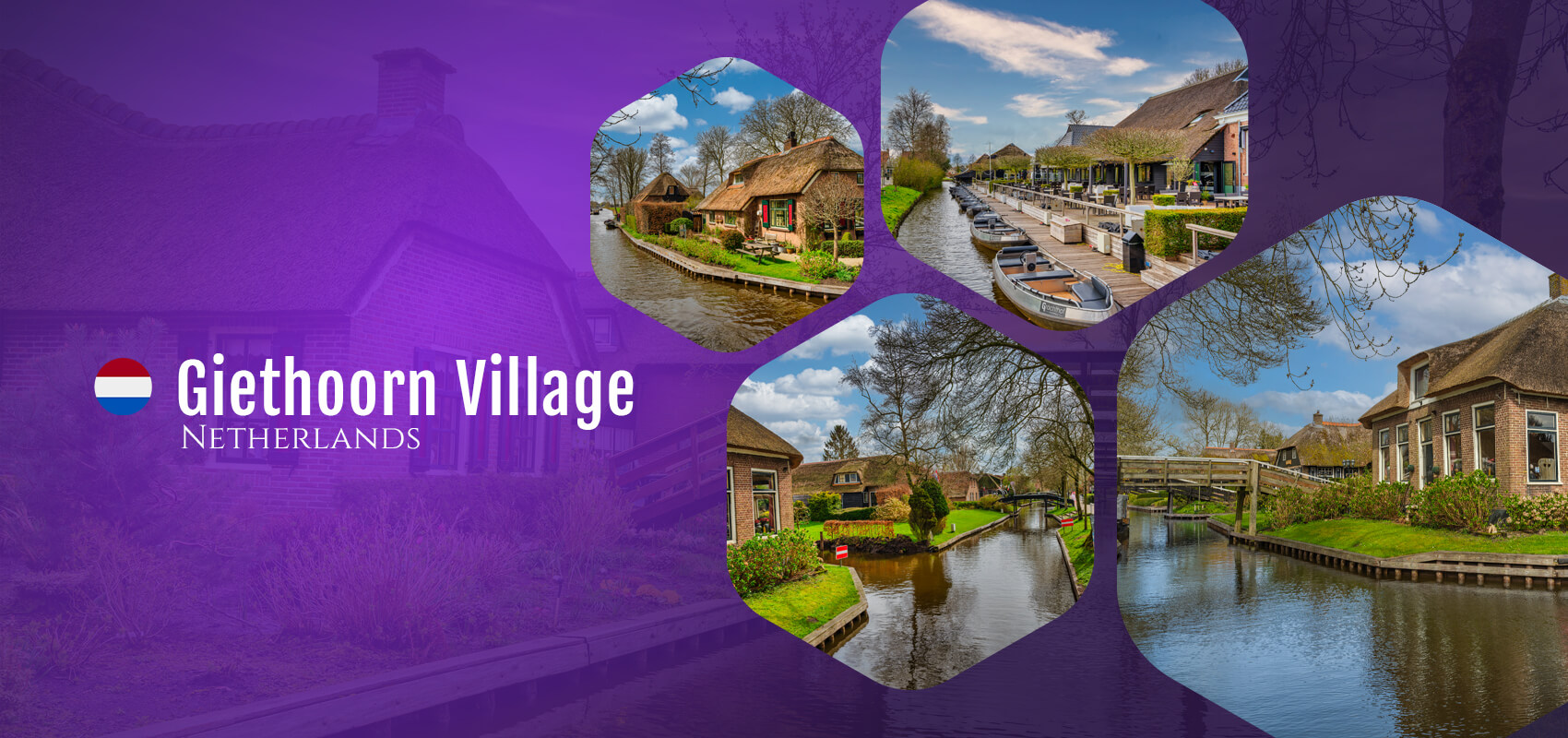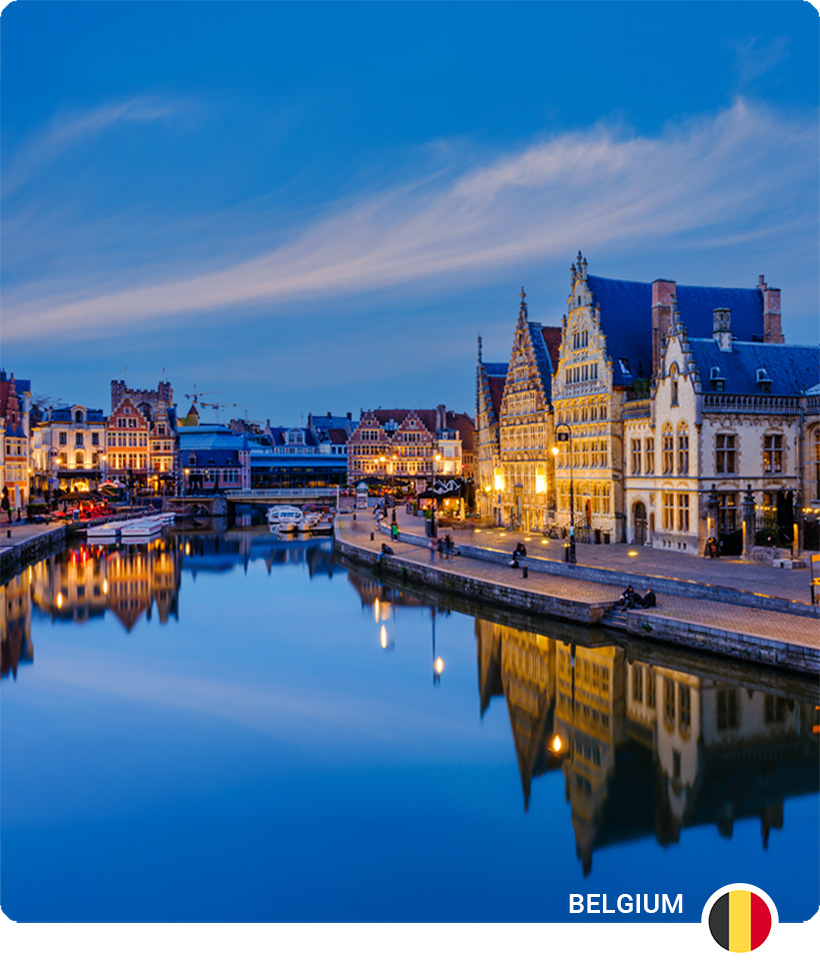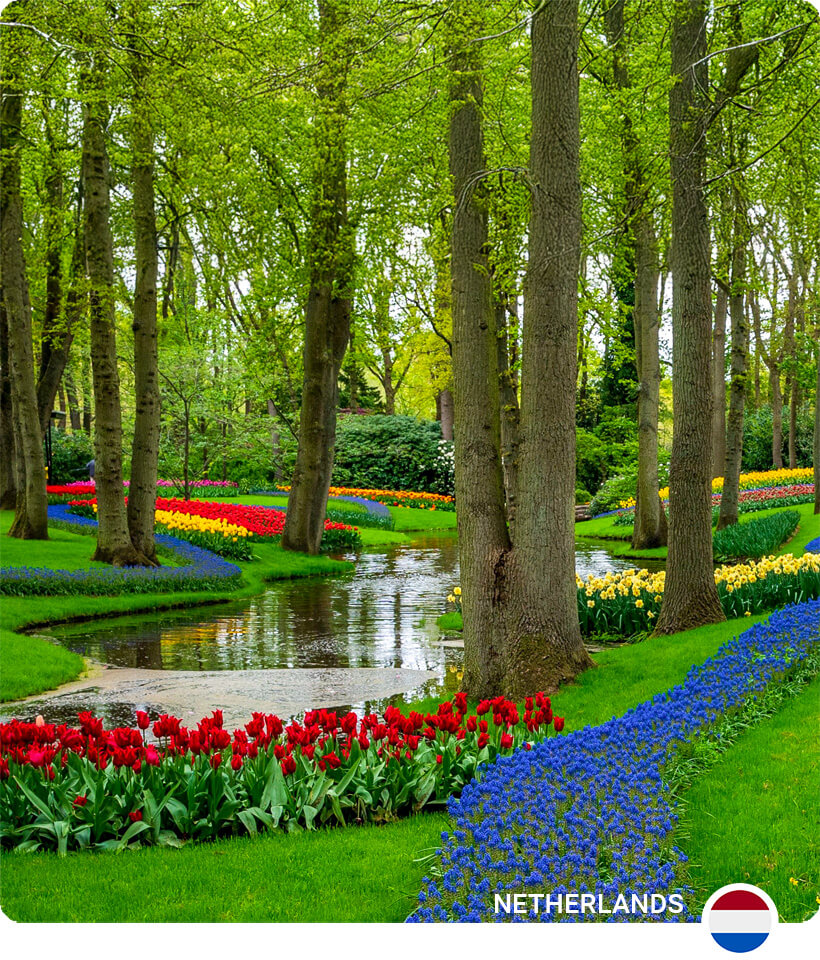Planning your unforgettable trip to Giethoorn, Netherlands? Prepare to be enchanted by the fairytale atmosphere of the famous “village without roads” with this essential Giethoorn travel guide. Picture yourself gliding silently down peaceful canals, the gentle hum of an electric boat the only sound breaking the tranquil quiet, as you pass picturesque thatched-roof farmhouses nestled like jewels on tiny islands, all connected by over 176 quaint, high-arched wooden bridges. It’s a special Dutch experience, a step back in time that feels worlds away from the everyday hustle.
Often nicknamed the “Dutch Venice” for its intricate network of waterways, Giethoorn offers a distinctly different feel – quieter, more intimate, and undeniably charming. To truly grasp its fairytale beauty and see these canals and cottages brought to life, pair this guide with our ‘Ultimate Travel Guide’ video – it’s the perfect visual introduction before diving into the details here.
Giethoorn’s magic lies in its complete reliance on waterways and its car-free heart. Unlike the bustling grandeur of Venice, Giethoorn provides a quieter, distinctly rural Dutch experience – think less city buzz, more quacking ducks and birdsong. This commitment preserves its unique tranquility and forces a wonderful slowdown, encouraging exploration by traditional ‘punters’, quiet electric ‘whisper boats’, bicycle, or simply on foot along lovely pathways. This guide provides the crucial Giethoorn tips you’ll need for exploring its car-free centre, discovering things to do, and understanding how to best soak in the serene beauty while navigating its well-deserved popularity.
A Village Born from Water: The History of Giethoorn
The very landscape of Giethoorn tells a fascinating story reaching back centuries. Its existence isn’t owed to modern planning, but to the arduous work of peat diggers around the 13th and 14th centuries. Settlers, including fugitives and later monks, manually dug canals through the marshland to extract peat, a vital fuel source when dried. This peat was laid out to dry on narrow strips of land (‘ribs’ or ‘legakkers’), and the digging created holes and trenches (‘weren’). Over time, and aided by significant floods in 1776 and 1825, these dug-out areas merged, forming the lakes and the intricate network of canals we see today.
This process literally carved the village out of the wetlands, creating numerous small islands upon which the characteristic thatched-roof farmhouses were built. These islands remain connected solely by the village’s distinctive wooden bridges. Even the village’s name is rooted in this watery history; early inhabitants reportedly found hundreds of goat horns (‘gietehorens’) scattered in the marsh, likely remnants from a major 10th or 12th-century flood, leading to the evocative name Giethoorn. Understanding this history adds another layer of appreciation to the village’s singular beauty.
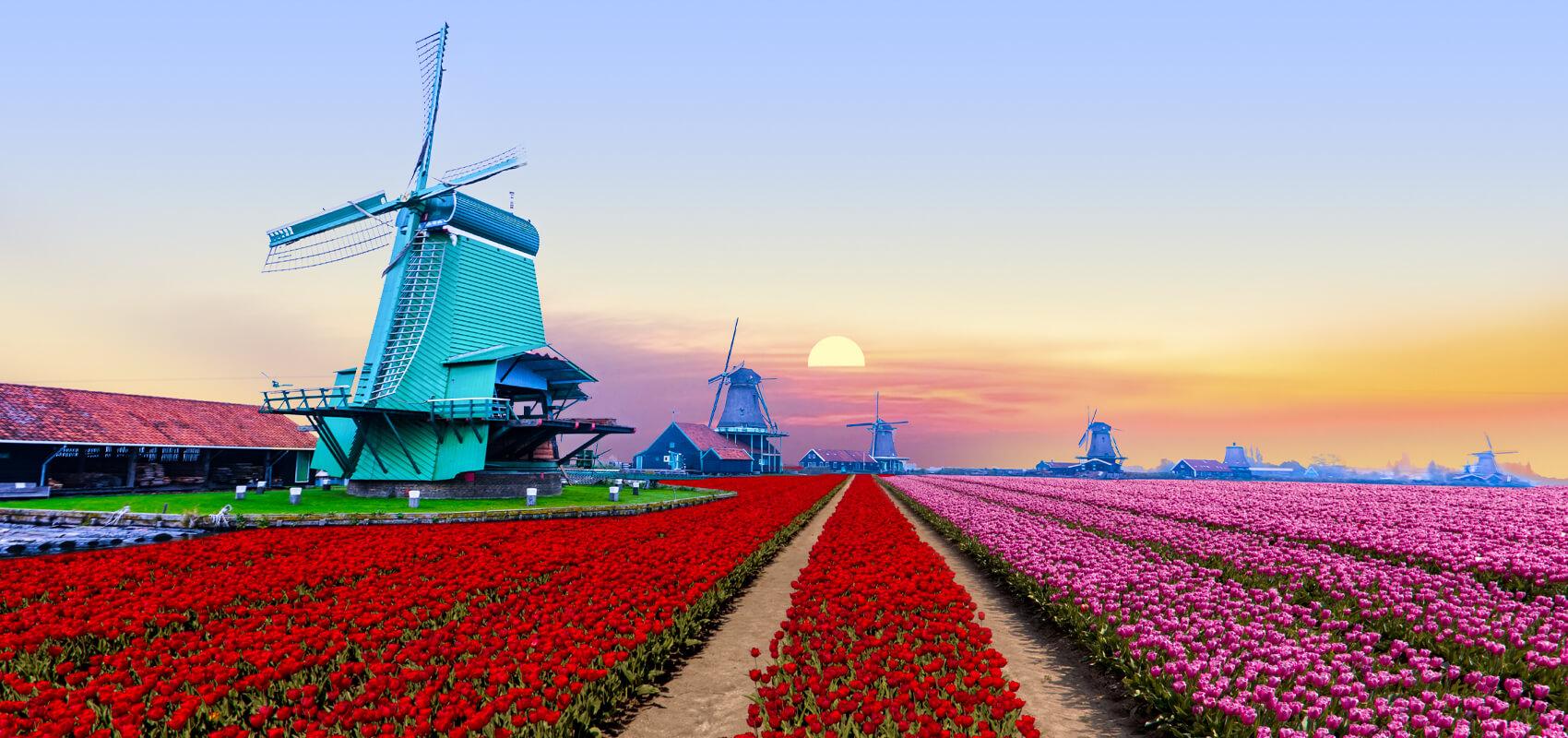 Dutch windmill surrounded by colourful tulip fields at sunset.
Dutch windmill surrounded by colourful tulip fields at sunset.
Getting To Giethoorn: Your Travel Options
So, you’re captivated by the idea of Giethoorn’s canals and charm? Fantastic! Figuring out how to reach this enchanting village is the next step. Planning your journey well ensures a smooth start to your adventure.
Giethoorn is nestled in the province of Overijssel in the northeastern Netherlands, beautifully situated within the Weerribben-Wieden National Park, the largest fenland area in Northwestern Europe. While it feels wonderfully remote, it’s reasonably accessible from major Dutch cities:
- From Amsterdam: The most common starting point, Amsterdam, is about 120 km away. Expect a drive of roughly 85 to 90 minutes.
- From Rotterdam: If coming from Rotterdam, the journey is approximately 176 km, taking about 1 hour and 45 minutes by car.
Here are the best ways to make the journey:
Option 1: Hit the Road – Driving to Giethoorn
Driving offers the most flexibility for exploring the Netherlands at your own pace. We personally chose this option and loved the freedom to discover interesting spots along the way. The Dutch road network is excellent, making even picturesque villages like Giethoorn easy to reach.
- The Route: Your journey will mostly be on smooth highways (max speed 100 km/h). As you approach Giethoorn, the final 15 minutes or so will typically be on smaller, scenic ‘N’ roads (max 80 km/h) and ‘B’ roads (max 50 km/h) winding towards the village area.
- Navigation: Using a GPS or navigation app is highly recommended. Setting the destination to an address like ‘Binnenpad 88’ in Giethoorn can guide you effectively towards the edge of the car-free zone where parking is available.
- Practicalities: Car rentals are widely available throughout the Netherlands. Remember your driver’s license! Also, note that since 2012, minor children need their own travel documents; they can no longer be included just in a parent’s passport. (We’ll cover parking specifics next – remember, you can’t drive into the historic center!)
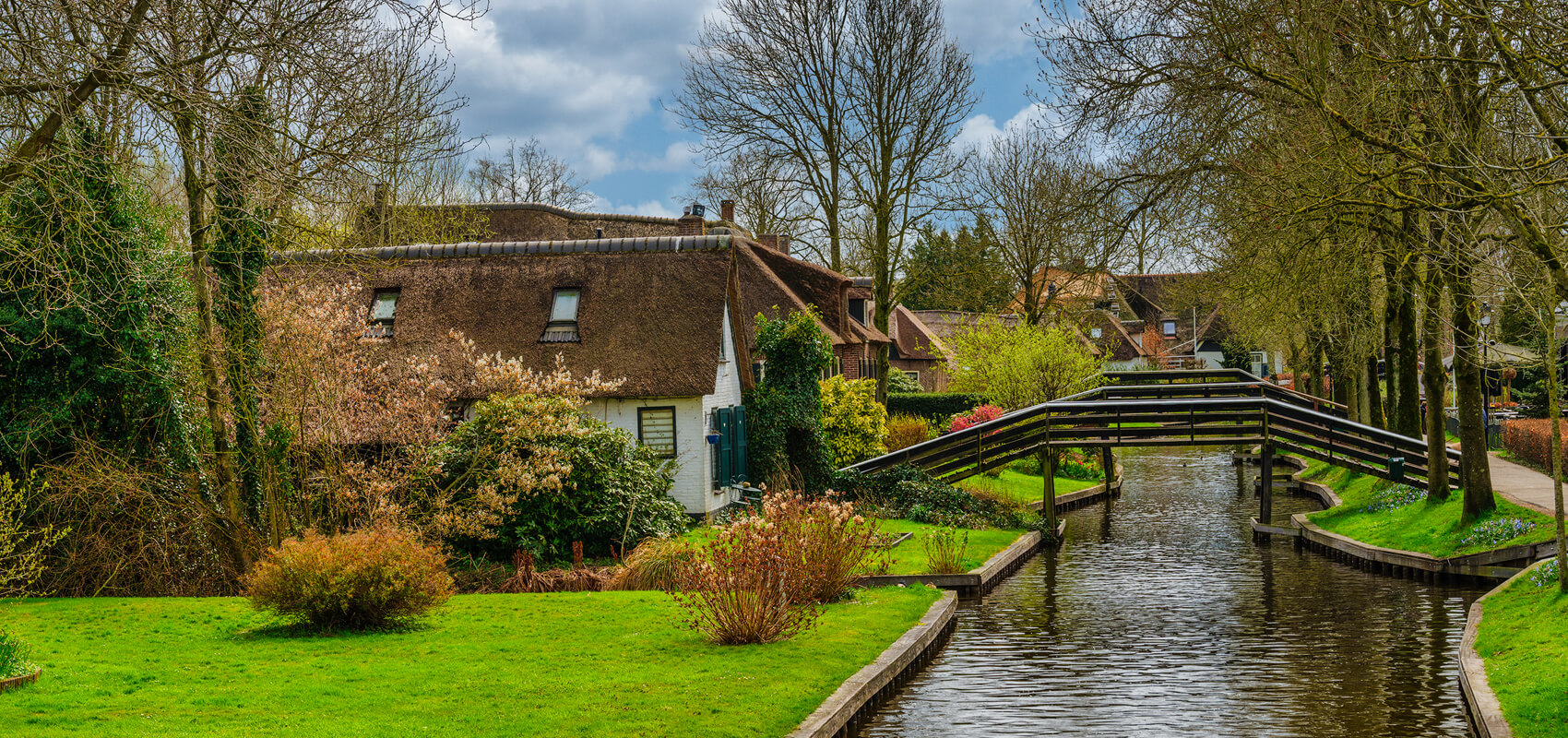 Geithoorn village canals and wooden bridges with charming thatched roof houses on the canal side
Geithoorn village canals and wooden bridges with charming thatched roof houses on the canal side
Option 2: Go Public – Train & Bus Combination
Prefer to sit back, relax, and enjoy the Dutch scenery? Taking public transport is a very viable and eco-friendly option. It typically involves a comfortable train journey followed by a connecting bus service that takes you right to the edge of Giethoorn.
- Combined Tickets: Keep an eye out for special day-trip packages offered by transport companies. These often bundle the train fare, the bus connection, and sometimes even include a 1-hour canal cruise upon arrival, frequently advertised for around €26. This can be a convenient and budget-friendly choice. (Check official Dutch public transport planners like NS (Nederlandse Spoorwegen) for train schedules and 9292.nl for integrated travel planning including buses).
Option 3: Join a Tour – Organized Day Trips
For ultimate ease and convenience, especially if you’re based in Amsterdam, consider an organized day tour. Numerous operators offer trips to Giethoorn.
- What’s Included: These tours usually provide round-trip transportation in a comfortable coach, often include a guided boat tour in Giethoorn (saving you the hassle of arranging it yourself), and sometimes combine the visit with other Dutch highlights like the iconic Zaanse Schans windmills or the impressive Afsluitdijk causeway.
- Timing: Tours typically depart Amsterdam mid-morning (around 9 or 10 AM) and return in the late afternoon or early evening, giving you several hours to explore Giethoorn itself. (Booking these tours online in advance is highly recommended, especially during peak season to secure your spot).
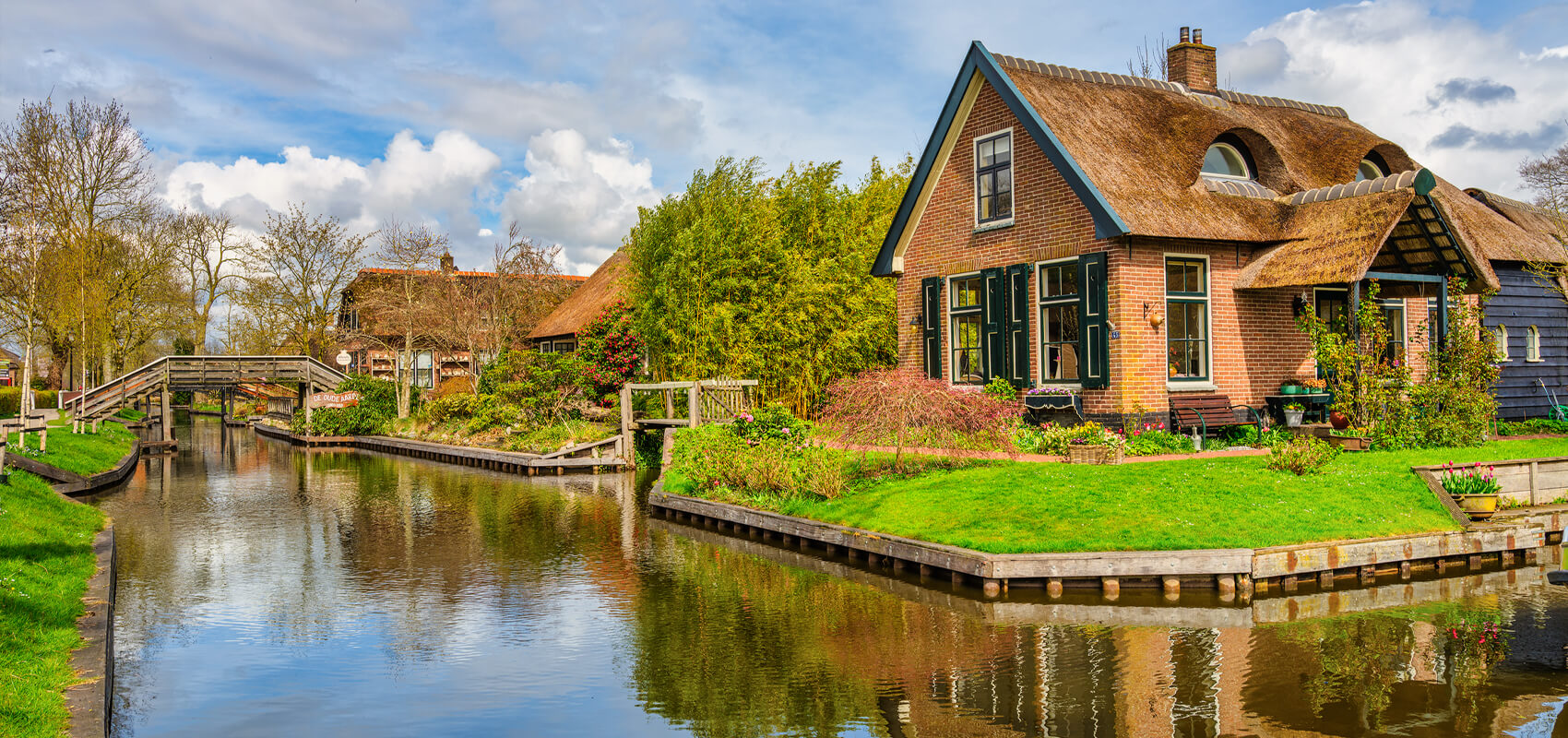 Giethoorn Waterways Charming Thatched Houses.
Giethoorn Waterways Charming Thatched Houses.
Other Options (Less Common)
While technically possible, taking a taxi or using ride-sharing services like Uber from major cities will likely be significantly more expensive due to the distance involved. Hiring a private guide who includes transportation offers a personalized experience but typically comes at a higher cost.
Choosing how you’ll get to Giethoorn depends on your budget, preferred travel style, and starting point. Whether driving yourself, relaxing on public transport, or joining a guided tour, the journey leads to the same enchanting, car-free destination!
Parking & Entering the Village
You’ve arrived near Giethoorn! Now, what about the car? As we’ve highlighted, a defining feature – and a huge part of its charm – is the car-free village center. When the era of cars arrived, the locals wisely decided to preserve the historic heart of the village, meaning visitors need to park their vehicles on the outskirts and continue their journey using more traditional, peaceful methods.
Don’t worry, Giethoorn is well-prepared for visitors arriving by car with an efficient parking system:
- Follow the ‘P-Route’: As you approach, look for clear, colour-coded ‘P-Route’ signs (Green for the center approach, Red for the South, Yellow for the North). These will guide you smoothly to designated parking areas situated conveniently on the village periphery. There’s ample space, with multiple lots offering over 1600 spots combined.
- Free Parking is King: A major advantage for visitors is that most of these official parking spots are completely free of charge. This fantastic, well-thought-out system acts as the necessary gateway between the modern road network and the historic village, making day trips very feasible and accessible.
- Convenient Location: From almost any parking spot within this P-Route system, you’re only a very short, pleasant walk (maximum 4-5 minutes) away from the village center, the picturesque canals, boat rental points, inviting restaurants, and the local supermarket. The large tourist parking area designated ‘Green P1’, located adjacent to the Plus supermarket Ter Schure in the center, is particularly handy if you want to grab supplies before exploring.
- Paid Option & Fines: While free parking is the norm, be aware there is at least one paid lot (‘Middenbuurt P1’), costing roughly €6 for a day ticket. Crucially, avoid the temptation to park outside designated areas, as you risk a hefty fine (around €120). Stick to the marked zones.
- Business Parking: Many local businesses cater directly to guests arriving by car. Hotels like Hotel de Harmonie, Hotel de Kruumte, and Hotel Giethoorn often offer their own private, free parking exclusively for their customers. Similarly, many restaurants and boat rental companies provide free parking spaces for patrons, which is ideal if you’re staying overnight or planning a longer meal or boat trip.
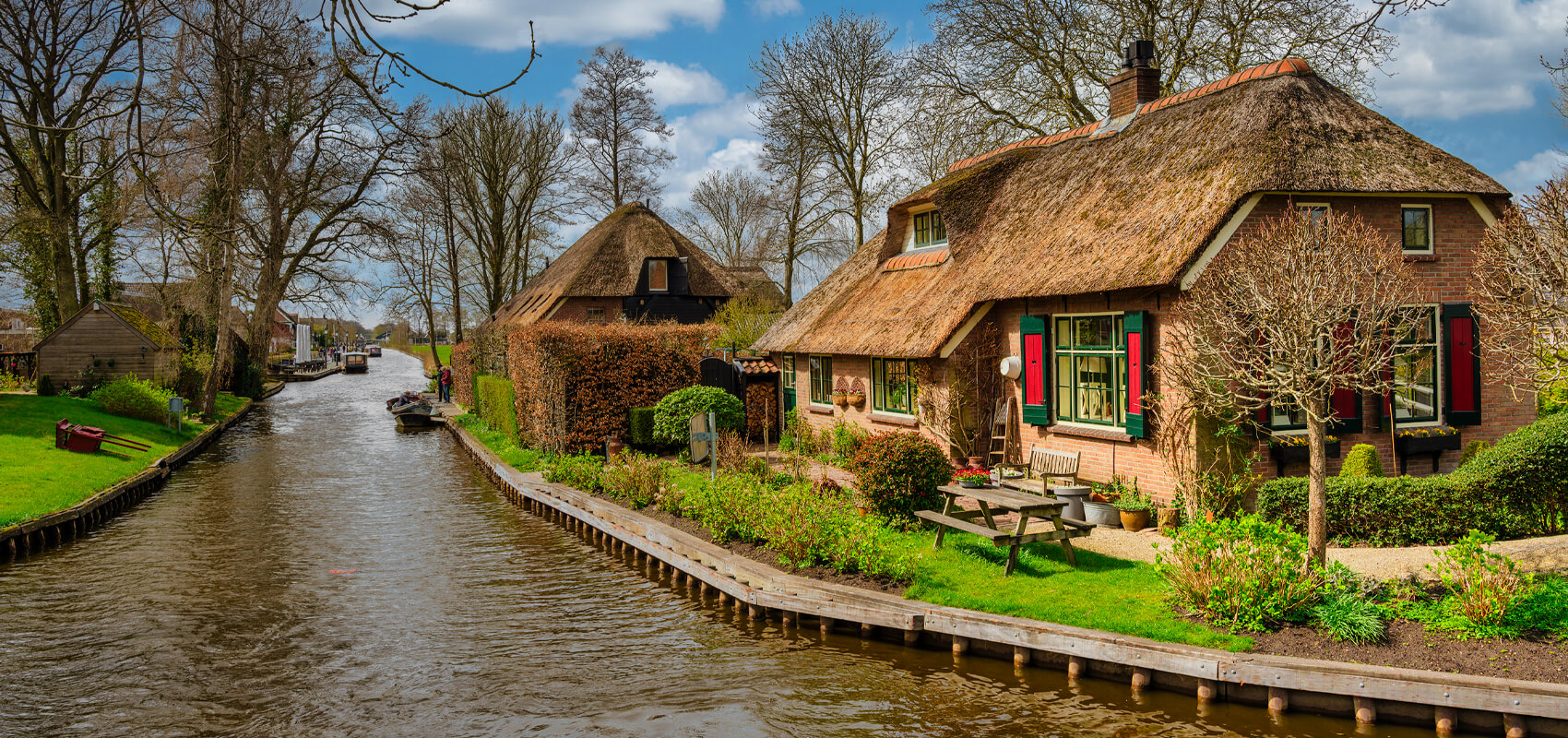 Charming thatched houses along the canal in Geithoorn.
Charming thatched houses along the canal in Geithoorn.
Things to Do in Giethoorn: Canals, Culture & Cuisine
Once you’ve parked (or arrived by bus/tour), the real Giethoorn adventure begins! Getting around the village center means embracing its traditional modes of transport: gliding silently in boats on the canals, strolling along delightful footpaths and bridges, or perhaps exploring further afield by bicycle. Here’s a guide to the memorable experiences, sights, and tastes awaiting you:
1. By Boat: The Quintessential Experience
This is truly the best way to immerse yourself in Giethoorn’s atmosphere and capture its spirit. Gliding through the canals is a wonderful experience, offering perspectives you simply can’t get otherwise.
- Whisper Boats (‘Fluisterboot’): The most popular choice for exploring independently. These open boats use quiet electric motors (hence the name!), ensuring the village’s tranquility is preserved. They are remarkably easy to steer, and no boating license is needed. Renting typically costs €40-€60+ per hour depending on the boat size. It’s a fantastic way to feel like a local for a while!
- Sloops: Slightly larger or more luxurious open electric boats are also available for rent if you desire a bit more space or comfort.
- Punters: You might also see traditional flat-bottomed wooden boats, historically used for transporting everything from peat to cattle. Many available for rent now also have electric motors, blending tradition with convenience.
- Guided Canal Cruises: A fantastic, relaxing alternative if you prefer not to navigate yourself. These typically last about 1 hour and use larger, often covered boats (some are wheelchair accessible), making them suitable for all weather conditions. An experienced local skipper navigates while providing insightful commentary about the village’s history and culture, often in multiple languages. Prices usually range from €10 to €15 per person, sometimes including coffee. Great if you want shelter or local knowledge without the effort of steering.
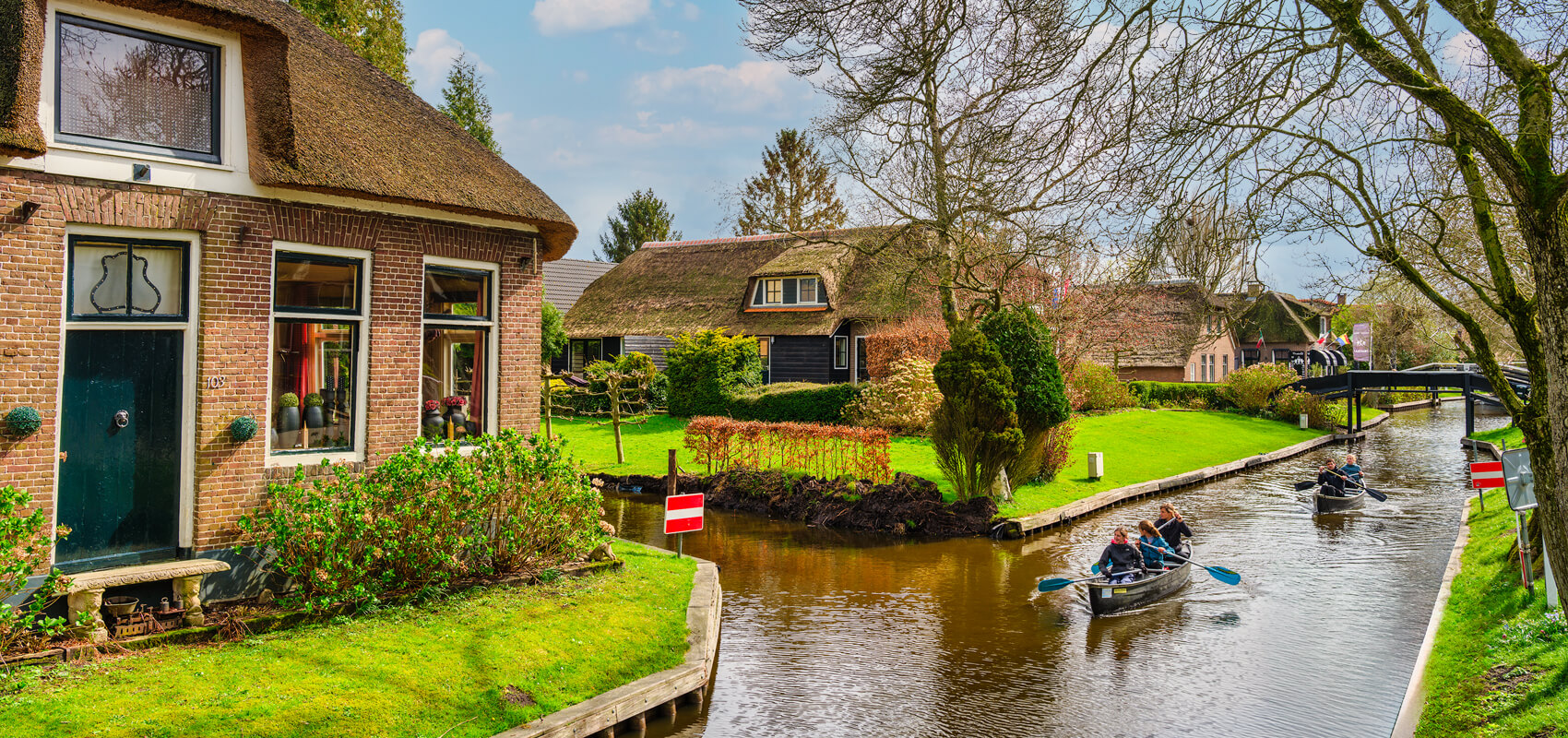 Tourists exploring Geithoorn canals by boats and enjoying the charming village views.
Tourists exploring Geithoorn canals by boats and enjoying the charming village views.
- Private Tours: For a more personalized experience, you can hire a boat with your own private local skipper/guide.
- Routes & Duration: Rentals range from just one hour (perfect for covering the main village canal loop) to a full day for extensive exploration. Popular 1.5-2 hour routes often include the village loop and extend onto the scenic Bovenwijde lake. Longer routes allow exploration further into the serene Weerribben-Wieden National Park. Rental companies provide helpful sailing maps or access to apps showing various routes.
- Booking Ahead is Crucial: Due to Giethoorn’s popularity, it is strongly advised to book your rental boat (especially whisper boats/sloops) online in advance. This is particularly important for weekends (April-September), public holidays, school holidays, and even winter when fewer boats operate. Booking ahead saves time searching upon arrival and guarantees you get a boat, avoiding disappointment. (You can find rental options on sites like Giethoorn Village Boat Rental or Grachthof Giethoorn Boat Rental)
- Active Paddling: For a closer connection to the water, consider renting a canoe or trying stand-up paddleboarding (SUP).
2. By Foot: Picturesque Paths & Bridges
While boating is primary, exploring Giethoorn on foot offers a different, more intimate perspective on village life and allows you to appreciate details up close.
- Paths & Bridges: Strolling along the main footpath, the ‘Binnenpad’, which runs beside the central canal, is an absolute must. It offers postcard-perfect views of the iconic farmhouses, their immaculate gardens bursting with colour, and reflections dancing on the water. Discover other lovely paths like Langesteeg and Zuiderpad. You’ll inevitably cross many of the village’s 176+ iconic wooden bridges, each offering a unique vantage point and photo opportunity.
- Local Icon Spotting: While wandering, keep an eye out for the statue of Albert Mol. Mol was a beloved Dutch actor who starred as a quirky conductor in the classic 1958 comedy film Fanfare. This film, shot right here in Giethoorn, played a massive role in putting the village on the map. Finding his statue, often noted near the Binnenpad and the aptly named Café Fanfare (itself a location from the film), is a fun nod to the village’s cinematic history and enduring charm.
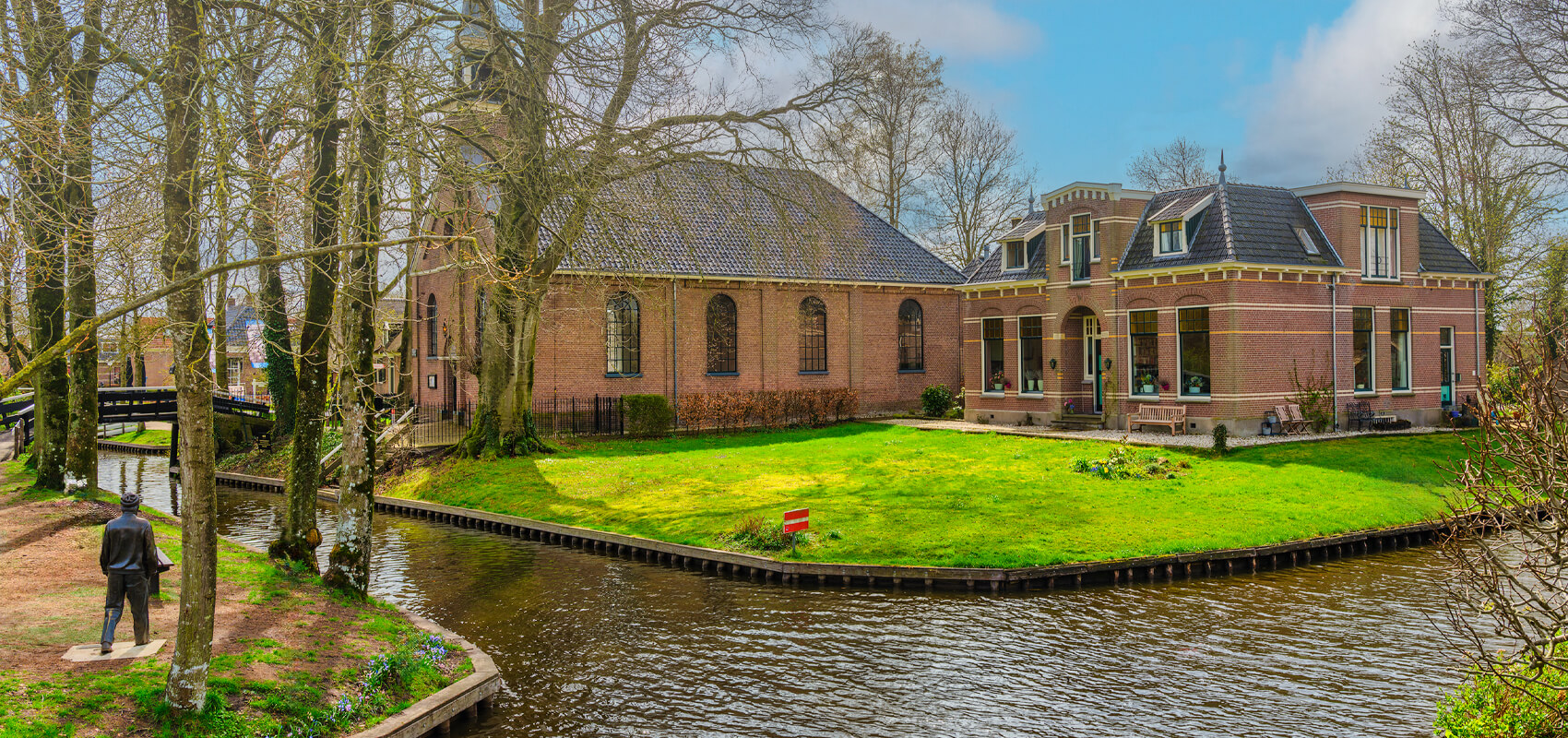 Geithoorn village Albert Mol statue and church square scene.
Geithoorn village Albert Mol statue and church square scene.
- Mindful Walking & Photography: Remember that the footpaths can be narrow and are often shared with cyclists, so stay aware of your surroundings. Giethoorn is incredibly photogenic, but patience might be needed for the perfect shot, especially during busy times. Most importantly, respect residents’ privacy. Admire the beautiful homes and gardens from public paths and canals only; do not wander into private gardens, linger on private bridges (many houses have their own!), or peer into windows.
3. By Bicycle: Covering More Ground
Renting a bike is a great way to explore the edges of the village where the footpaths might end, and to venture further into the beautiful surrounding national park.
- Rental Options: Various bikes are available to suit different needs, including standard city bikes, e-bikes for easier cruising, kids’ bikes, and even fun options like electric scooters or choppers for longer distances.
- Marked Routes: Look for marked cycle paths like the 41.5 km ‘Giethoorn de Wieden fietsroute’, a fantastic trail showcasing the best of the village and the marshy landscapes beyond.
4. Museums, History & Nature
Gain a deeper appreciation for Giethoorn by exploring its heritage and stunning natural surroundings. Visiting the local museums provides essential context.
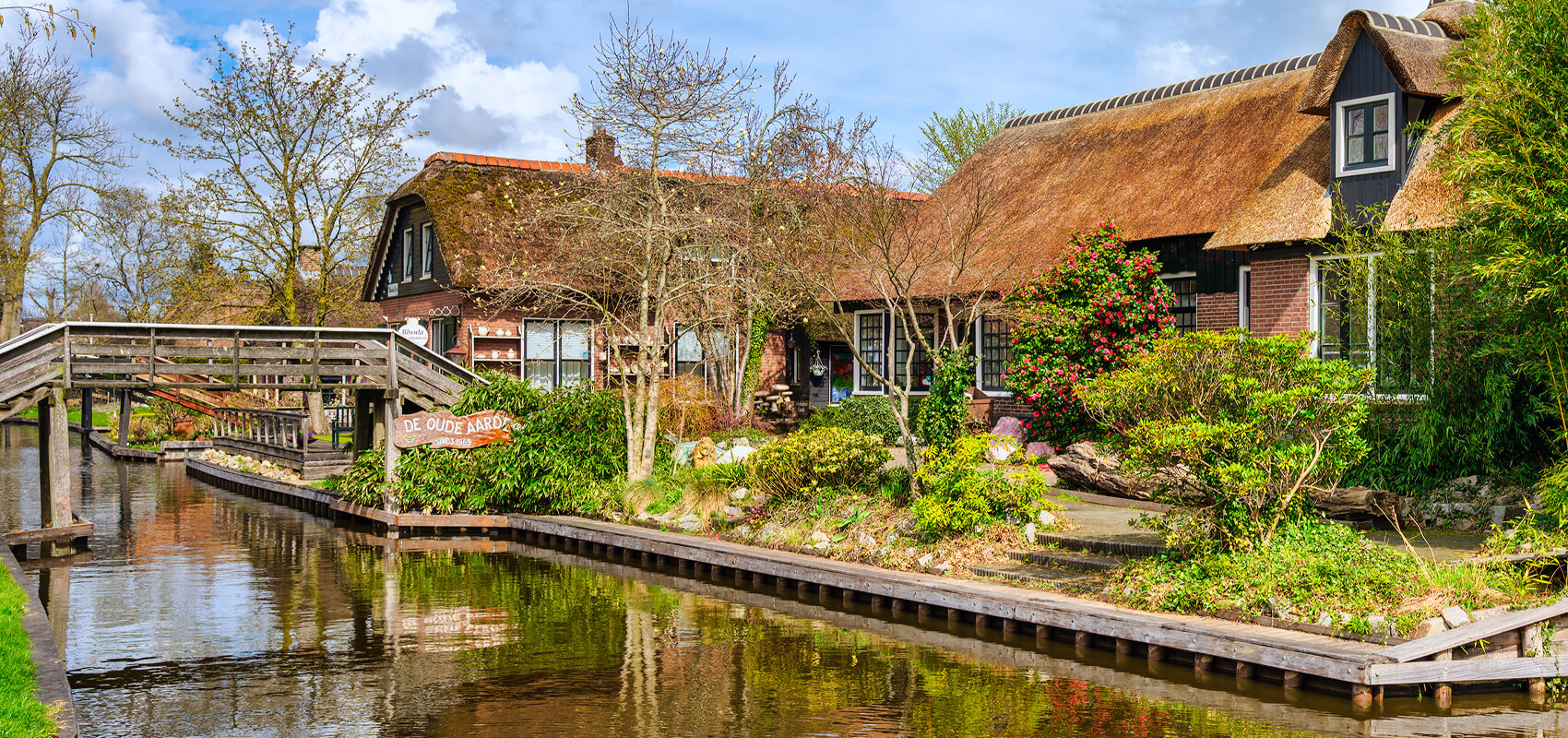 Geithoorn village canal side featuring Old Earth Museum.
Geithoorn village canal side featuring Old Earth Museum.
- Museum Giethoorn ‘t Olde Maat Uus: Step back in time inside an authentic historic farmhouse. This museum brings the village’s past to life, showcasing its origins in peat-digging, traditional farming methods, fishing practices, and daily life in historic Giethoorn. You can explore traditional interiors and sometimes even encounter actors in period attire demonstrating old crafts.
- Museum de Oude Aarde: Marvel at a unique and fascinating private collection of gemstones, minerals, and fossils gathered from across the globe by its founder. Exhibits are often dramatically displayed, highlighting their natural beauty.
- Weerribben-Wieden National Park: Remember Giethoorn is nestled within this vast and ecologically significant national park. Explore its diverse landscape of lakes, ponds, canals, reed beds, and marsh forests – all resulting from centuries of peat extraction. It’s a haven for nature lovers, offering opportunities for extended boat trips, canoeing, cycling routes, and fantastic wildlife spotting. Keep an eye out for various bird species like Coots, Moorhens, Lapwings, Oystercatchers, and majestic Mute Swans often seen gliding on the water.
5. Dining & Dutch Treats
Exploring the canals and pathways is sure to work up an appetite! Luckily, Giethoorn offers delightful ways to rest, refresh, and experience local flavours, often with incredible views.
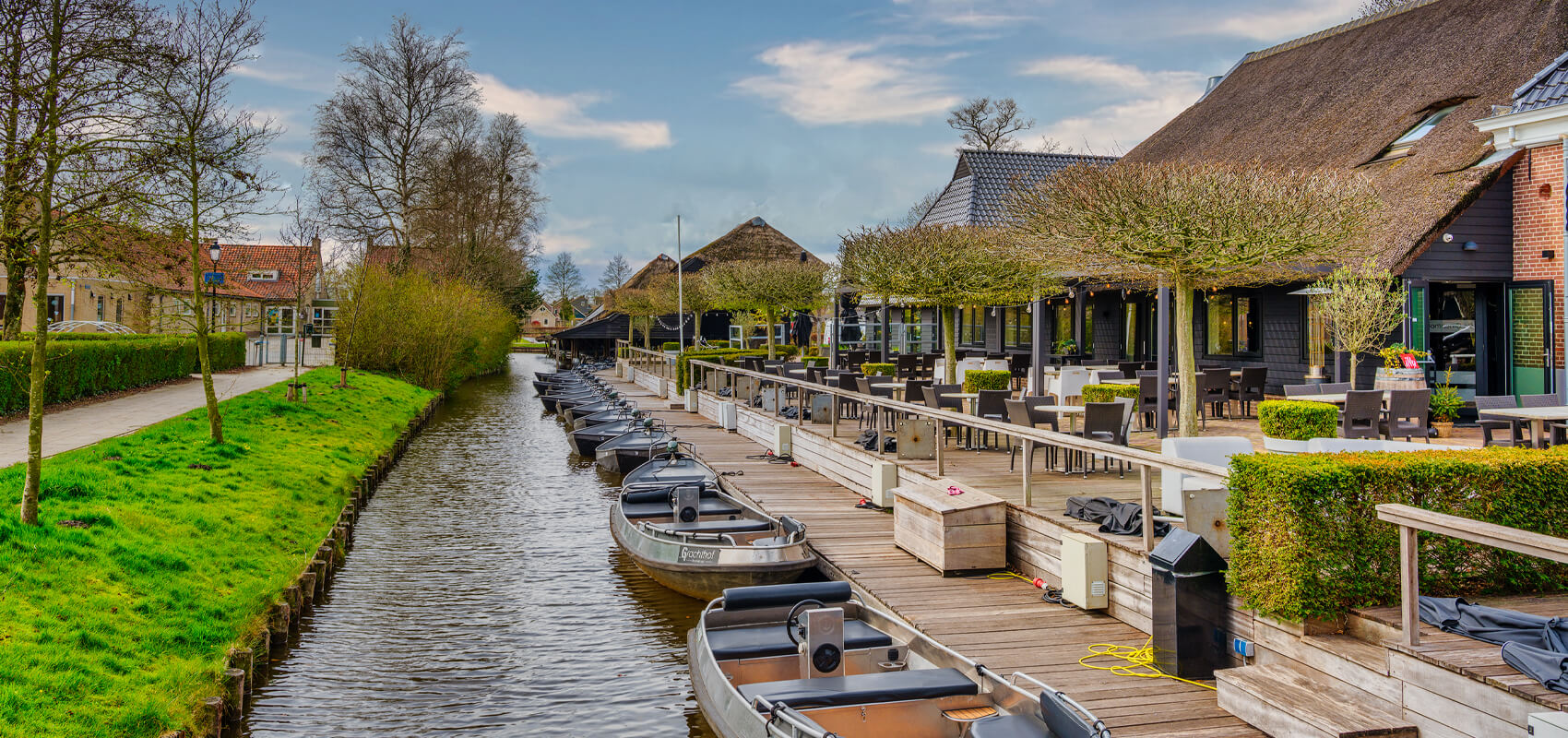 Giethoorn restaurant overlooking canal beautiful scenery.
Giethoorn restaurant overlooking canal beautiful scenery.
- Waterside Dining: One of the true pleasures here is enjoying a meal or a relaxing drink right by the water. Many restaurants and cafes feature lovely terraces directly overlooking the canals. Find a spot, watch the whisper boats glide by, and soak in the serene atmosphere. You’ll find plenty of options along the main ‘Binnenpad’ walking route. Being surrounded by water, fresh seafood often features prominently on menus.
- Must-Try Dutch Snacks: While enjoying the scenery, be sure to sample some classic Dutch delicacies:
- Stroopwafel: Don’t miss trying this famous Dutch treat – two thin, crisp waffle layers pressed together with a warm, gooey caramel syrup filling. Simple, sweet, and utterly delicious!
- Poffertjes: Look out for stalls selling these traditional delights! They are small, fluffy, puffed-up pancakes, typically served warm with a knob of butter and a generous dusting of powdered sugar.
- Bitterballen: A quintessential Dutch savory snack, perfect with a local beer. These are deep-fried balls with a crunchy breadcrumb coating, filled with a smooth, savory beef or veal ragout. They’re traditionally served with mustard for dipping.
6. Other Village Activities
Depending on your interests and time, Giethoorn offers a few more diversions:
- Enjoy a round of mini-golf or test your aim with archery.
- Browse the local shops along the Binnenpad for souvenirs, local crafts, or delicacies.
- Visit the Schreur shipyard to see how traditional wooden punts are built.
- Find a scenic spot along a canal or in a park area for a relaxing picnic.
- Look into a hands-on cooking class to learn about traditional Dutch dishes.
For those planning a longer stay in the region, charming historic towns like Zwolle and Kampen are within easy driving distance and offer further exploration.
Pro Tips for Your Giethoorn Visit
A little planning and local insight can make your trip to Giethoorn even more magical. Here are some essential pro tips:
Timing Your Visit
When you visit can significantly impact your experience due to Giethoorn’s popularity.
- Best Seasons: While lovely year-round, Spring (April-May) with its blossoming flowers and Fall (September-October) with its autumn colours often offer pleasant weather and potentially fewer crowds than the peak summer months (July-August). Summer is lively with long daylight hours perfect for boating, but be prepared for it to be busy.
- Best Days/Times: Weekdays generally see fewer visitors than weekends. To experience Giethoorn at its most serene and magical, aim to arrive early (before 10 am) before most day tours arrive, or linger later into the late afternoon and evening as the crowds thin out. Staying overnight is the ultimate way to enjoy the peaceful golden hours of morning and evening.
- Winter Visits: Don’t rule out a winter trip! The village takes on a different, quiet charm, often dusted with frost. While most rental boats are stored for maintenance, some may still be available (booking is essential!). If the canals freeze solid (an increasingly rare event), you might witness the truly magical sight of locals ice skating along the waterways.
 Binnenpad Street Giethoorn canal side street with most attractions & Accommodations.
Binnenpad Street Giethoorn canal side street with most attractions & Accommodations.
Accommodation
Giethoorn offers charming places to stay, including hotels, B&Bs, and self-catering holiday homes, often blending seamlessly with the village aesthetic. However, options within the village itself are limited and highly sought after. Booking accommodation well in advance is absolutely essential, especially if travelling during peak season, weekends, or holidays, to secure your preferred choice and avoid disappointment. (Consider looking in nearby towns like Zwolle or Steenwijk for potentially more availability and budget-friendly options if village lodging is full).
What to Bring
Pack appropriately for a comfortable visit:
- Comfortable walking shoes are absolutely essential for exploring the footpaths and bridges.
- Layers of clothing – Dutch weather can be notoriously changeable, even within a single day. Be prepared for sun, cloud, wind, or rain.
- Camera – It’s incredibly photogenic, you’ll want to capture the memories!
- Sunscreen (even on cloudy days, the sun reflecting off the water can be strong) and perhaps insect repellent in warmer months.
- Water bottle to stay hydrated, and maybe some snacks or supplies for a picnic if you plan to find a quiet spot.
Accessibility & Respectful Tourism
A few important considerations for your visit:
- Accessibility: Giethoorn’s historic infrastructure, with its narrow footpaths, numerous steps onto bridges, and small boats, can present challenges for visitors with mobility issues. While some larger covered tour boats are noted as being accessible, independent exploration requires careful consideration. It’s best to inquire directly with accommodation providers and boat rental companies about specific accessibility needs beforehand.
- Respect Locals & Environment: Remember Giethoorn is home to around 2,800 people who share their beautiful village with nearly a million visitors annually. Be mindful of noise levels, especially when operating boats (even whisper boats aren’t completely silent) and particularly near homes. Stay on public paths and bridges; do not trespass into private gardens or onto private boat docks. Responsible, considerate tourism helps mitigate issues like congestion and noise, ensuring Giethoorn remains special for residents and future visitors alike.
Conclusion: Experience the Giethoorn Fairytale
We hope this guide and our companion video have given you a taste of Giethoorn’s unique magic – its charming canals, thatched cottages, and car-free tranquility. Whether you’re gliding on the water, exploring paths, diving into history, or sampling Dutch treats, it’s an enchanting escape. Just remember, Giethoorn’s popularity makes mindful planning and respectful tourism essential to preserve its fairytale charm for everyone.
Now it’s your turn to explore this captivating corner of the Netherlands, discover its hidden details, and create lasting memories in the unforgettable village of Giethoorn. Happy travels!
Our Photography Portfolio
The photographs featured in this Giethoorn Travel guide were captured during the filming of our accompanying video. If you want to license these specific images, or explore thousands more from around the world that we’ve created over 14+ years, you can find our portfolios on major stock platforms below:
- Shutterstock: Shutterstock
- Adobe Stock: Adobe Stock
- Getty Images: Getty Images
- Depositphotos: Depositphotos
Helpful Links
- Giethoorn Tourism: Giethoorn Tourism
- Giethoorn Village Info: Giethoorn Village Info
- Tourist Information Giethoorn: Tourist Information Giethoorn
- Weerribben-Wieden National Park: Weerribben-Wieden National Park
- Museum Giethoorn ‘t Olde Maat Uus: Museum Giethoorn ‘t Olde Maat Uus
- Museum de Oude Aarde: Museum de Oude Aarde
